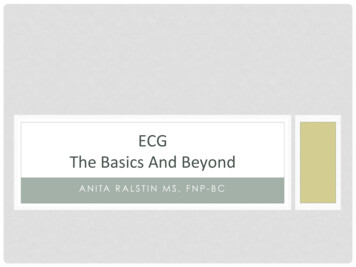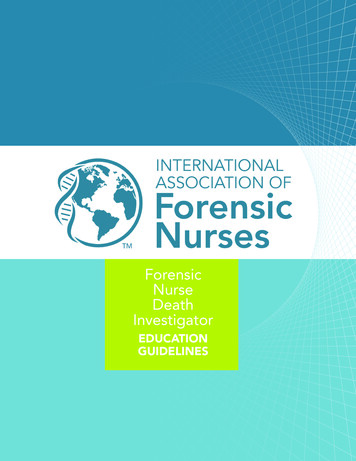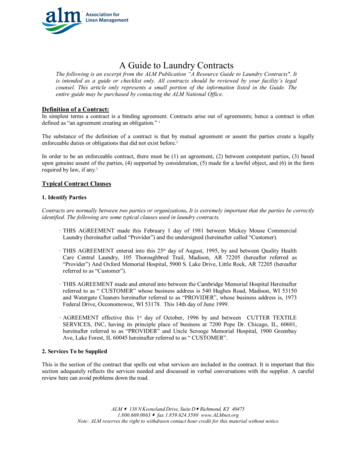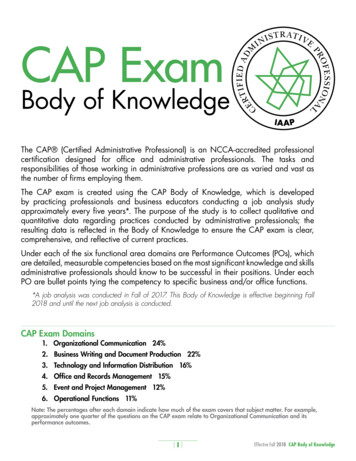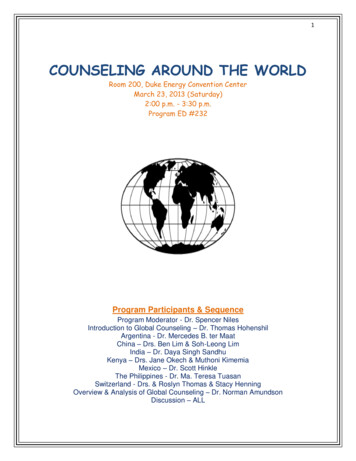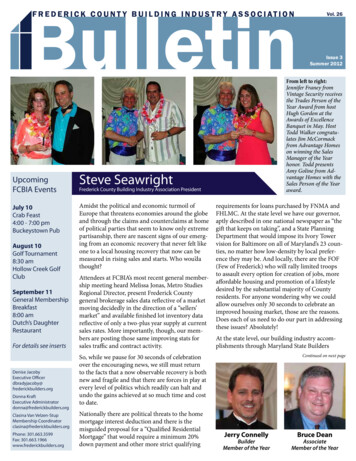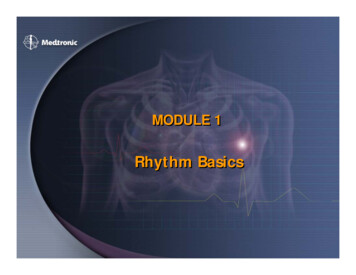
Transcription
MODULE 1Rhythm Basics
Module 1: Rhythm BasicsOverview The Conduction System––––Impulse FormationImpulse ConductionProperties of Cardiac Function5 Phases of Action Potential Rhythm Disorders––MechanismsArrhythmia Recognition Causes of Rhythm Disorders
Module 1: Rhythm BasicsObjectives Identify the components that make up theelectrical pathway known as the conductionsystem State the 5 phases of action potential Describe the mechanisms causing rhythmdisorders Identify rhythm disorders on an EKG
THE CONDUCTION SYSTEM
Heart Beat AnatomySINUS NODESinus Node(SA Node) The Heart’s ‘Natural Pacemaker’- 60-100 BPM at rest
Heart Beat AnatomyAV NODESinus Node(SA Node)AtrioventricularNode (AV Node) Receives impulse fromSA Node Delivers impulse to the HisPurkinje System 40-60 BPM if SA Node fails todeliver an impulse
Heart Beat AnatomyBUNDLE OF HISSinus Node(SA Node)AtrioventricularNode (AV Node)Bundle of His Begins conduction tothe Ventricles AV Junctional Tissue:40-60 BPM
Heart Beat AnatomyTHE PURKINJE NETWORKSinus Node(SA Node)AtrioventricularNode (AV Node)Bundle of HisBundle BranchesPurkinje Fibers Bundle Branches Purkinje Fibers Moves the impulse throughthe ventricles for contraction Provides ‘Escape Rhythm’:20-40 BPM
Normal Sinus Rhythm*AnimationClick heart toview animation
Impulse Formation In SA Node
Atrial Depolarization
Delay At AV Node
Conduction Through Bundle Branches
Conduction Through Purkinje Fibers
Ventricular Depolarization
Plateau Phase of Repolarization
Final Rapid (Phase 3) Repolarization
Normal EKG Activation
Reading EKGsIntervals and TimingNormal Rangesin Milliseconds: PRPR IntervalInterval 120120 –– 200200 msmsQRSQRS ComplexComplex 6060 –– 100100 msmsQTQT IntervalInterval 360360 –– 440440 msms
Question?Where does the SA Node get its energy?
AutomaticityCardiac Cells haveAUTOMATICITY!
AutomaticityCardiac Cells Spontaneously depolarize Generally present in: Upper (SA Node)- 60-100 BPM Middle (AV Junction)- 40-60 BPM Lower (Purkinje Network)- 20–40 BPM
AutomaticityOnce a pacemaker cell initiates an impulse,its neighboring cells follow suit – like dominos!
Question?What Triggers the First Cell?
Action Potential of a Cardiac Cell5 Phases
Action Potential of a Cardiac Cell5 Phases Phase 0–– RapidRapid oror upstrokeupstrokedepolarizationdepolarization withwith anan influxinfluxofof sodiumsodium ionsions intointo thethe cellcell
Action Potential of a Cardiac Cell5 Phases Phase 0–– RapidRapid upstrokeupstrokedepolarizationdepolarization withwith anan influxinfluxofof sodiumsodium ionsions intointo thethe cellcell Phase 1–– EarlyEarly rapidrapid repolarizationrepolarizationwithwith transienttransient outwardoutwardmovementmovement ofof potassiumpotassium ionsions
Action Potential of a Cardiac Cell5 Phases Phase 0–– RapidRapid upstrokeupstrokedepolarizationdepolarization withwith anan influxinfluxofof sodiumsodium ionsions intointo thethe cellcell Phase 1–– EarlyEarly rapidrapid repolarizationrepolarizationwithwith transienttransient onwardonwardmovementmovement ofof potassiumpotassium ionsions Phase 2–– PlateauPlateau Phase:Phase: ContinuedContinuedInfluxInflux ofof SodiumSodium && slowslowInfluxInflux ofof CalciumCalcium
Action Potential of a Cardiac Cell5 Phases Phase 0–– RapidRapid upstrokeupstrokedepolarizationdepolarization withwith anan influxinfluxofof sodiumsodium ionsions intointo thethe cellcell Phase 1–– EarlyEarly rapidrapid repolarizationrepolarizationwithwith transienttransient onwardonwardmovementmovement ofof potassiumpotassium ionsions Phase 2–– PlateauPlateau Phase:Phase: ContinuedContinuedInfluxInflux ofof SodiumSodium && slowslowInfluxInflux ofof CalciumCalcium Phase 3–– Repolarization:Repolarization:PotassiumPotassium outflowoutflow
Action Potential of a Cardiac Cell5 Phases Phase 0–– RapidRapid upstrokeupstrokedepolarizationdepolarization withwith anan influxinfluxofof sodiumsodium ionsions intointo thethe cellcell Phase 1–– EarlyEarly rapidrapid repolarizationrepolarizationwithwith transienttransient onwardonwardmovementmovement ofof potassiumpotassium ionsions Phase 2–– PlateauPlateau Phase:Phase: ContinuedContinuedInfluxInflux ofof SodiumSodium && slowslowInfluxInflux ofof CalciumCalcium Phase 3–– Repolarization:Repolarization:PotassiumPotassium outflowoutflow Phase 4–– RestingResting PhasePhase
Action Potential of a Cardiac CellRefractory Periods ERP - EffectiveRefractory Period–Phases 0, 1, 2 and earlyPhase 3–A depolarization cannotbe initiated by animpulse of any strength
Action Potential of a Cardiac CellRefractory Periods RRP - RelativeRefractory Period–Late Phase 3 and earlyPhase 4–A strong impulse cancause depolarization,possibly with aberrancy
Action Potential of a Cardiac CellEffective & Relative Refractory Periods
Question?Now that we understand impulse formationand normal heart function, let’s think What can possibly go wrong?
RHYTHM DISORDERS
Rhythm Disorders2 Categories of Rhythm DisordersDisorders ofImpulse FormationImpulse Conduction
Rhythm DisordersUnderlying MechanismsImpulse FormationImpulse Conduction AbnormalAbnormal AutomaticityAutomaticity
Mechanisms of Rhythm DisordersAbnormal AutomaticityAbnormally Slow Bradycardia Failure due to diseaseExcessively Rapid Tachycardia Due to sympathetic nervous system
Mechanisms of Rhythm DisordersImpulse Formation AbnormalAbnormal AutomaticityAutomaticity TriggeredTriggered ActivityActivityImpulse Conduction
Mechanisms of Rhythm DisordersTriggered Activity Afterpotentials occurring inPhase 3 (early) or 4 (late) ofaction potential Can trigger arrhythmias
Mechanisms of Rhythm DisordersTriggered ActivityEarly AfterdepolarizationLate Afterdepolarization Potential Causes: - Low potassium blood levels- Slow heart rate- Drug toxicity (ex. Quinidinecausing Torsades de Pointes)Potential Causes:– Premature beats– Increased calcium bloodlevels– Increased adrenalinelevels– Digitalis toxicity
Mechanisms of Rhythm DisordersUnderlying MechanismsImpulse Formation AbnormalAbnormal AutomaticityAutomaticity TriggeredTriggered ActivityActivityImpulse Conduction SlowSlow oror BlockedBlockedConductionConduction
Mechanisms of Rhythm Disorders*AnimationSlowed or Blocked Conduction ImpulseImpulse generatedgenerated normallynormally ImpulseImpulse slowedslowed oror blockedblocked asas itit makesmakes itsits waywaythroughthrough thethe conductionconduction systemsystem
Mechanisms of Rhythm DisordersUnderlying MechanismsImpulse Formation AbnormalAbnormal AutomaticityAutomaticity TriggeredTriggered ActivityActivityImpulse Conduction SlowSlow oror BlockedBlockedConductionConduction Reentry
Mechanisms of Rhythm DisordersConditions of ReentryReentry
Mechanisms of Rhythm DisordersReentrySubstrate Trigger Reentry
Mechanisms of Rhythm DisordersReentry
ReentryIdentifying Reentry Pace the heart at a rate faster than theknown intrinsic tachycardia rate Stop the pacing If the intrinsic rate resumes tachycardic,then reentry is identified
RHYTHM DISORDERSBradyarrhythmias
Bradyarrhythmia ClassificationsClassification Based on DisorderImpulse FormationDisordersBradycardiasImpulse ConductionDisorders
Bradyarrhythmia ClassificationsClassification Based on DisorderImpulse FormationDisordersImpulse ConductionDisorders SinusSinus ArrestArrest
Sinus Arrest*Animation Failure of sinus node discharge Absence of atrial depolarization Periods of asystole
Bradyarrhythmia ClassificationsClassification Based on DisorderImpulse FormationDisordersImpulse ConductionDisorders SinusSinus ArrestArrest SinusSinus BradycardiaBradycardia
Sinus Bradycardia Sinus Node emits energy very slowly
Bradyarrhythmia ClassificationsClassification Based on DisorderImpulse FormationDisordersImpulse ConductionDisorders SinusSinus ArrestArrest SinusSinus BradycardiaBradycardia Brady/TachyBrady/Tachy SyndromeSyndrome
Brady/Tachy Syndrome Intermittent episodes of slow andfast rates from the SA node or atria Brady 60 BPM Tachy 100 BPM
Bradyarrhythmia ClassificationsClassification Based on DisorderImpulse FormationDisorders SinusSinus ArrestArrest SinusSinus BradycardiaBradycardia Brady/TachyBrady/Tachy SyndromeSyndromeImpulse ConductionDisorders ExitExit BlockBlock
Exit Block Transient block of impulses from the SA node Identified by P-P interval relationship
Bradyarrhythmia ClassificationsClassification Based on DisorderImpulse FormationDisorders SinusSinus ArrestArrest SinusSinus BradycardiaBradycardia Brady/TachyBrady/Tachy SyndromeSyndromeImpulse ConductionDisorders ExitExit BlockBlock 11stst DegreeDegree AVAV BlockBlock
First-Degree AV Block PR interval 200 ms Delayed conduction through the AV Node- Example shows PR Interval 320 ms
Bradyarrhythmia ClassificationsClassification Based on DisorderImpulse FormationDisorders SinusSinus ArrestArrest SinusSinus BradycardiaBradycardia Brady/TachyBrady/Tachy SyndromeSyndromeImpulse ConductionDisorders ExitExit BlockBlock 11stst DegreeDegree AVAV BlockBlocknd Degree 22ndDegree AVAV BlockBlock
Second-Degree AV Block - Mobitz I*AnimationKnown as Wenckebach Block Progressive prolongation of the PR interval untilthere is failure to conduct and a ventricular beatis dropped
Second-Degree AV Block – Mobitz II Regularly dropped ventricular beats– Ex: 2:1 block (2 P-waves to 1 QRS complex)– Atrial rate 75 BPM– Ventricular rate 42 BPM
Bradyarrhythmia ClassificationsClassification Based on DisorderImpulse FormationDisorders SinusSinus ArrestArrest SinusSinus BradycardiaBradycardia Brady/TachyBrady/Tachy SyndromeSyndromeImpulse ConductionDisorders ExitExit BlockBlock 11stst DegreeDegree AVAV BlockBlocknd Degree 22ndDegree AVAV BlockBlockrd Degree 33rdDegree AVAV BlockBlock
Third-Degree AV Block*Animation No impulse conduction from the atria to theventricles– Ventricular rate 37 BPM– Atrial rate 130 BPM– PR interval variable
Bradyarrhythmia ClassificationsClassification Based on DisorderImpulse FormationDisorders SinusSinus ArrestArrest SinusSinus BradycardiaBradycardia Brady/TachyBrady/Tachy SyndromeSyndromeImpulse ConductionDisorders ExitExit BlockBlock 11stst DegreeDegree AVAV BlockBlocknd Degree 22ndDegree AVAV BlockBlockrd Degree 33rdDegree AVAV BlockBlock Bi/TrifascicularBi/Trifascicular BlockBlock
Bifascicular Block A complete or incomplete block in at least twoconduction system pathways below the AV Node Marked by a widened QRS
Bifascicular BlockRightRight bundlebundlebranchbranch blockblockandand leftleft anterioranteriorhemiblockhemiblockRightRight bundlebundlebranchbranch blockblock andandleftleft te leftleftbundlebundle branchbranchblockblock
Trifascicular Block Complete block in the right bundle branch, andComplete or incomplete block in both divisions of theleft bundle branch Identified by EP Study
Bradyarrhythmia ClassificationsSummaryImpulse ConductionDisordersImpulse FormationDisorders SinusSinus ArrestArrestSinusSinus BradycardiaBradycardiaBrady/TachyBrady/Tachy SyndromeSyndrome ExitExit BlockBlock11stst DegreeDegree AVAV BlockBlocknd Degree22ndDegree AVAV BlockBlock--MobitzMobitz II (Wenckebach(Wenckebach Block)Block)-Mobitz-Mobitz IIIIrd Degree 33rdDegree AVAV BlockBlock Bi/TrifascicularBi/Trifascicular BlockBlock
RHYTHM DISORDERSTachyarrhythmias
Terms Describing Tachycardias Paroxysmal– Ectopic focus, sudden onset, abrupt cessation Sustained––Duration of 30 secondsRequires intervention to terminate Non-Sustained– At least 6 beats or 30 seconds– Spontaneously terminates Recurrent––Occurs periodicallyPeriods of no tachycardia are longer thanperiods of tachycardia
Terms Describing Tachycardias Incessant– Long periods of tachy, short periods of NSR Monomorphic– Single focus– Complexes are similar with equal intervals Polymorphic– Multiple foci– Complexes appear different with varied intervals SVT (Supraventricular Tachycardia)– Originating from above the ventricles
Tachyarrhythmia ClassificationsClassification Based on DisorderImpulse FormationDisordersTachycardiasImpulse ConductionDisorders
Tachyarrhythmia ClassificationsClassification Based on DisorderImpulse FormationDisordersImpulse ConductionDisorders Sinus Tachycardia
Sinus Tachycardia Origin:Sinus Node Rate:100-180 BPM Mechanism:Abnormal (Hyper) Automaticity
Tachyarrhythmia ClassificationsClassification Based on DisorderImpulse FormationDisordersImpulse ConductionDisorders Sinus Tachycardia Atrial Tachycardia
Atrial Tachycardia Origin:Atrium - Ectopic Focus Rate: 100 BPM Mechanism:Abnormal Automaticity
Tachyarrhythmia ClassificationsClassification Based on DisorderImpulse FormationDisordersImpulse ConductionDisorders Sinus Tachycardia Atrial Tachycardia Premature Contractions
Premature BeatsPremature Atrial Contraction (PAC) Origin:Atrium (outside the Sinus Node) Mechanism:Abnormal Automaticity Characteristics: An abnormal P-wave occurringearlier than expected, followedby compensatory pause
Premature BeatsPremature Junctional Contraction Origin:AV Node Junction Mechanism:Abnormal Automaticity Characteristics: A normally conducted complex withan absent p-wave, followed by acompensatory pause
Premature BeatsPremature Ventricular Contractions (PVCs) Origin:Ventricles Mechanism:Abnormal Automaticity Characteristics: A broad complex occurring earlierthan expected, followed by acompensatory pause
PVC Patterns Bigeminy- Every other beat Trigeminy- Every third beat Quadrigeminy- Every fourth beat
Multifocal PVC Origin:Varies within the Ventricl
Module 1: Rhythm BModule 1: Rhythm Baasicssics The Conduction System – Impulse Formation – Impulse Conduction – Properties of Cardiac Function – 5 Phases of Action Potential Rhythm Disorders – Mechanisms – Arrhythmia Recognition Causes of Rhythm Disorders The Conduction System – Impulse Formation – Impulse Conduction – Properties of Cardiac Function
